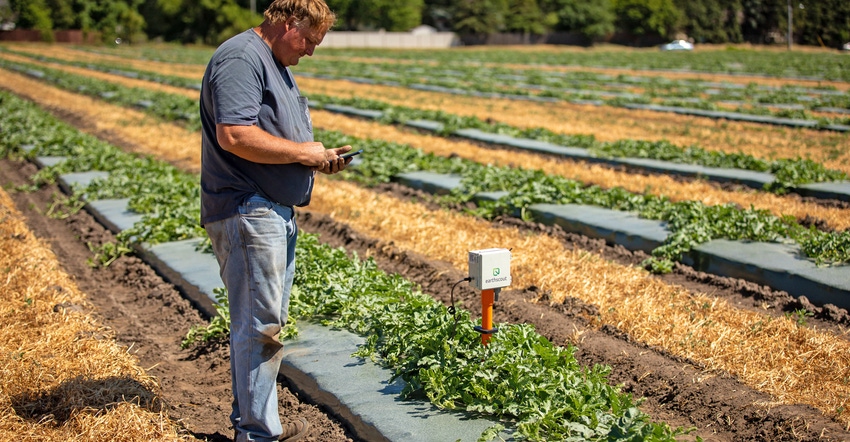
Producers have many options when it comes to precision ag technology for planting and harvest.
Many companies, from Silicon Valley startups to established agricultural companies, have tools to help farmers more precisely apply nutrients to fields or more accurately keep track of yields.
EarthScout GBC, a Minnesota-based company, wants to stand out as a leader in tracking real-time, in-season data to help farmers decide if they need to apply more nutrients or pesticides, or whether to turn on the irrigation system.
After four years of refining its technology, the EarthScout GBC team is hitting the farm trade show circuit with its line of EarthScout remote sensors for indoor and outdoor growing.
The sensors — units mounted on tripods that are placed in a field or greenhouse — collect micro-climate and soil data in real time, sharing it wirelessly with growers through an app or web-based application. The units operate 24 hours a day recording field conditions the entire time.
So what do these sensors track? Well, that depends on how much you’re willing to spend.
“It's just like buying a truck. You get the base model and then you get to add on different features, and in this case, the features are actual datapoints," says Josh Krenz, the company’s chief operating officer.
The company offers separate indoor and outdoor units with base, middle and top-end models. Outdoor sensors, for example, start with the L200 model, which includes sensors that track air temperature and humidity; and soil moisture, electrical connectivity and temperature.
The midtier L400 includes one additional soil moisture, soil electrical connectivity and soil temperature sensor. The top-end L600 includes all those sensors, plus an additional one that tracks solar radiation.
Prices range from $2,299 for the base model to $3,499 for the top end L600.
For its indoor sensors, the base A200 tracks everything indoors that the base L200 tracks outdoors. The midtier A400 has additional sensors that track air carbon dioxide and air/soil dioxide. The top-end A600 has all those sensors, plus a quantum light sensor and a telescoping aluminum pole for extending the unit above the canopy.
Prices range from $2,299 for the base to $4,499 for the A600. There are also lease-to-own options available.
“So when we sit down with a farmer, we sit down and figure out what data is important to them, whether it’s soil temperature, electrical conductivity, air temperature humidity, and then we help them choose a model,” Krenz says.
Krenz says the company developed the units to be “crop agnostic,” meaning they can be used in any field application, from corn and soybeans to tree fruits and vegetables, or indoor tomato greenhouses and hydroponic facilities.
The number of sensors a farmer should have really depends on what they’re doing and what their goals are.
“On 100 acres, the farmer might farm those acres completely the same, or they might break it up into a couple of different sections,” Krenz says. “What we want to do is place the right amount of EarthScout units with those sensors out there to help that farmer measure the things they can manage in that field.”
The units themselves are mounted on a tripod with air measurement sensors mounted on the box and corded sensors that can be placed in the ground — the cords can go up to 20 feet.
The units weigh about 9 pounds.
So how can these minicomputers withstand nasty weather? Krenz says the units are a spinoff of Design Ready Controls, a company that makes control panels for the HVAC industry, and the oil and gas industry.
“They specialize in making equipment that can last in harsh conditions, but more specifically, electronic equipment,” he says.
The company spent five years developing the units and has been working with various Midwest growers, as far east as Indiana, on refining the units and the technology used.
"We're helping those farmers with that in-season, real-time data that can help them make better decisions in the season because they already have other precision tools that they're using before the season, whether it's variable-rate planting or anything else going on in the cab, and they've got a lot of tools at the end of the season,” Krenz says. “But in the middle of the season is where I think we can help farmers enhance data they're using to make better decisions.”
So, why should you consider buying a unit?
“One of their differentiators, I think, is that it's farmer by farmer,” Krenz says. “We’re putting out there what's right for the individual producer, not just sensors we want to sell. The second thing is, farmers own the data. It's the grower’s data. The farmers own all that data. And for every EarthScout, we assign a growth coach to work on that farm. Those coaches stay with the farmer and work alongside them to help them interpret information and utilize it on the farm.”
The web app includes a tool that allows a user to download the sensor data into whatever farm management system they’re using.
“We’ve just made it very simple to download it into a usable format that is most commonly used across platforms to let them [users] use that data in ways that they want to consume it,” Krenz says.
For more information, visit earthscout.com.
About the Author(s)
You May Also Like






